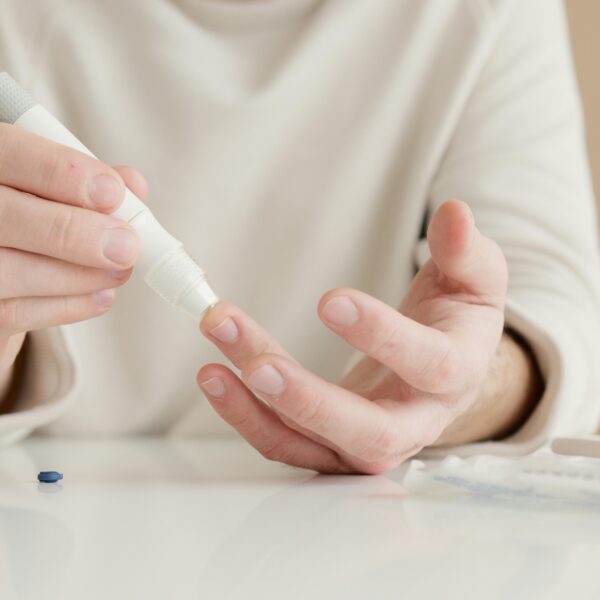Proinsulin to Insulin Conversion and Genetics
Aira
on
March 12, 2024
How Proinsulin Becomes Insulin
The human body is an amazing factory, constantly producing the necessary chemicals. Insulin, a key player in blood sugar regulation, is no exception. But insulin production doesn’t just appear randomly – it starts as a larger molecule called proinsulin. Here’s how it works:
- The Proinsulin Precursor
Imagine a car that needs assembly before it can hit the road. Proinsulin is like that – a larger precursor molecule containing the parts for mature insulin. It has three sections: the A and B chains, which will become the working parts of insulin and a connecting C-peptide.
- Secretory Vesicles
Proinsulin is manufactured in specialized cells within the pancreas called beta cells. Here, proinsulin is packaged into compartments known as secretory vesicles. Inside these vesicles, the magic happens.
- Enzymes Take Action
Two special enzymes are the key players, prohormone convertase 1/2 (PC 1/2) and carboxypeptidase E (CPE). They act like molecular scissors, snipping proinsulin at specific points. PC 1/2 separates the A and B chains from the C-peptide, while CPE removes a small extra bit from the C-peptide end.
- Setting the Stage
Interestingly, the conversion process is influenced by the acidity within the secretory vesicles. As these compartments mature, they become more acidic, creating the optimal environment for the enzymes to work their magic.
- The Final Product: Insulin
After the enzymatic cuts, the A and B chains link together to form mature insulin, ready for action. The C-peptide, though not part of insulin itself, is released alongside it and can be a marker for insulin production.

Why is Proinsulin Conversion Important?
Understanding this process is crucial for several reasons. Problems with proinsulin conversion can contribute to insulin deficiency, a hallmark of diabetes. Studying this conversion can also shed light on potential therapies for diabetes or other conditions affecting insulin production.
How Genetics May Influence Proinsulin to Insulin Conversion
While the conversion of proinsulin to insulin might seem like a straightforward cellular process, there’s a surprising amount of genetic influence at play. Certain variations in our DNA can impact how efficiently our bodies convert proinsulin to insulin.
ADCY5 Gene
The ADCY5 gene, specifically the rs11708067 variant, emerges as a significant influencer in proinsulin to insulin conversion. This genetic variant affects the enzymatic cleavage of proinsulin, altering the balance between proinsulin and insulin during the conversion process. Individuals with different genotypes at this locus display distinct patterns of proinsulin levels during an Oral Glucose Tolerance Test (OGTT), indicating a direct impact on the efficiency of proinsulin processing into mature insulin.
MADD Gene
The rs7944584 variant in the MADD gene plays a crucial role in proinsulin to insulin conversion. Individuals carrying this genetic variant exhibit impaired conversion dynamics, as evidenced by an elevated proinsulin-insulin ratio at various time points during an OGTT. The effect allele in MADD contributes to disruptions in the enzymatic processing of proinsulin, highlighting the significance of this gene in maintaining the balance between proinsulin and insulin levels.
Additionally, a 2010 study claims that carriers of the glucose-raising allele in MADD exhibit higher proinsulin levels, suggesting impaired proinsulin to insulin conversion. This finding underscores the critical role of MADD in the intricate process of insulin processing. It highlights its potential contribution to disruptions in glucose homeostasis, emphasizing the need for further exploration of MADD’s precise role in insulin regulation.
GLIS3 Gene
The rs7034200 variant in the GLIS3 gene exerts a nominal but noteworthy influence on proinsulin to insulin conversion. Although reaching only nominal significance, this genetic variant showcases a significant effect size, particularly in integrated and late-stage OGTT-derived conversion parameters. GLIS3 appears to regulate proinsulin cleavage, impacting the final balance of insulin produced during glucose stimulation.
Understanding the genetic factors influencing proinsulin conversion is a constantly evolving field. As research continues, more genes and mechanisms may be discovered. This knowledge could pave the way for personalized therapies targeting specific genetic variations to optimize insulin production and potentially help manage conditions, like diabetes, more effectively.
Non-Genetic Factors Influencing Proinsulin to Insulin Conversion
The conversion of proinsulin to insulin isn’t just a matter of genetics. Several other factors can influence this crucial step, ultimately impacting how efficiently the body regulates blood sugar levels.
Glucose Levels
Blood sugar acts as a signal for insulin production. When glucose levels rise, this triggers proinsulin release from beta cells. However, high glucose concentrations over time can lead to beta cell dysfunction and impaired proinsulin conversion.
Calcium Levels
Calcium plays a crucial role in several cellular processes, including the proinsulin conversion. Adequate calcium levels are essential for proper enzyme function and insulin release.
Zinc Deficiency
Zinc is a vital mineral for insulin production and storage. Deficiency can impair proinsulin conversion and contribute to insulin resistance.
Endoplasmic Reticulum Stress
The endoplasmic reticulum (ER) is the cellular compartment where proinsulin is folded. Chronic stress in the ER can disrupt protein folding and accumulate misfolded proinsulin, hindering its conversion to mature insulin.
In summary, numerous factors beyond just genetics play a role in proinsulin to insulin conversion. By optimizing these influences through healthy lifestyle choices or potential future interventions, we can support optimal insulin production.
Ways to Optimize Proinsulin to Insulin Conversion
Several potential strategies for enhancing proinsulin conversion have emerged. Although ongoing investigations continue to broaden our understanding, here are some avenues that show promise:
Keep Blood Sugar in Check
Maintain a balanced lifestyle with a healthy diet, regular exercise, and medication if needed. This helps prevent issues with the pancreatic beta cells and supports effective proinsulin processing.
Adjust Diet
Include foods rich in nutrients like calcium and zinc to help enzymes work well and potentially improve insulin production. What you eat can affect how efficiently proinsulin turns into insulin.
Consider Medications
Some prescription medications, like GLP-1 receptor agonists, commonly used for type 2 diabetes, may positively impact proinsulin processing.
Reduce Stress for Healthier Cells
Taking steps to manage stress and maintain overall cellular health indirectly supports better proinsulin folding and conversion. Stress, whether from daily life or other factors, can affect how cells function. Finding ways to handle stress might create a better environment for efficient proinsulin conversion.
In summary, these simple approaches provide different angles for making proinsulin conversion more effective. Ongoing research will likely uncover more strategies, but for now, these steps offer a starting point to enhance this essential process in managing blood sugar levels.
About the LifeDNA Wellness Report
As we navigate the intricate pathways of our health, understanding even complex factors like proinsulin conversion becomes pivotal. Imagine having personalized insights into your unique genetic traits related to your well-being. This is where the LifeDNA Wellness Report steps in. Going beyond generic advice, this tool provides tailored recommendations based on your genetic code, offering a holistic perspective on your well-being. By unlocking your genetic insights, you can take proactive steps towards a brighter, more informed lifestyle with the LifeDNA Wellness Report. Get it today!
Summary
- Proinsulin, an insulin precursor, undergoes enzymatic processing within secretory vesicles in the pancreas, involving key enzymes and influenced by vesicle acidity, resulting in the formation of mature insulin and the release of the C-peptide.
- Understanding proinsulin conversion is crucial for addressing insulin deficiency in conditions like diabetes, as problems in this process contribute to impaired insulin production.
- Genetic variations, particularly in the ADCY5, MADD, and GLIS3 genes, play significant roles in influencing proinsulin to insulin conversion, impacting enzymatic cleavage and the balance between proinsulin and insulin levels.
- Beyond genetics, factors like glucose and calcium levels, zinc deficiency, and endoplasmic reticulum stress affect proinsulin conversion, emphasizing the multifaceted nature of insulin regulation.
- Lifestyle choices, including maintaining good blood sugar levels, a nutrient-rich diet, stress management, and considering certain medications, offer strategies to enhance proinsulin conversion for optimal insulin production and blood sugar regulation.
References
- https://my.clevelandclinic.org/health/body/22601-insulin
- https://pubmed.ncbi.nlm.nih.gov/3536964/
- https://journals.plos.org/plosone/article?id=10.1371/journal.pone.0023639
- https://diabetesjournals.org/diabetes/article/59/5/1266/33343/Detailed-Physiologic-Characterization-Reveals
- https://www.ncbi.nlm.nih.gov/pmc/articles/PMC3934755/
- https://pubmed.ncbi.nlm.nih.gov/1375070/
- https://www.ncbi.nlm.nih.gov/pmc/articles/PMC3303544/
- https://www.ncbi.nlm.nih.gov/pmc/articles/PMC6940736/
*Understanding your genetics can offer valuable insights into your well-being, but it is not deterministic. Your traits can be influenced by the complex interplay involving nature, lifestyle, family history, and others.
Our reports and suggestions do not diagnose or treat any health conditions or provide any medical advice. Consult with a healthcare professional before making any major lifestyle changes or if you have any other concerns about your results.














